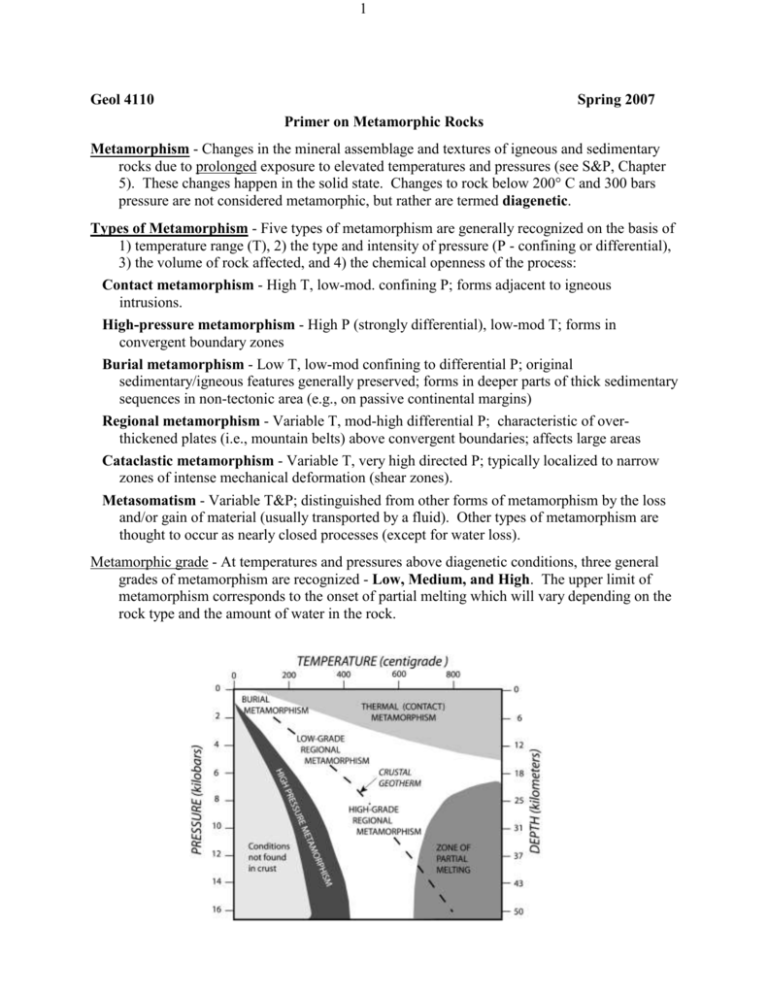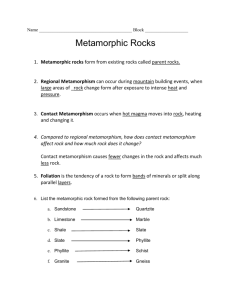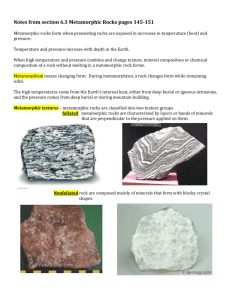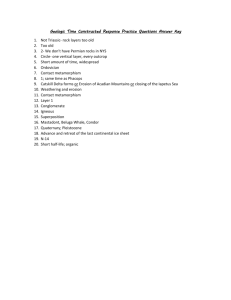Word
advertisement

1 Geol 4110 Spring 2007 Primer on Metamorphic Rocks Metamorphism - Changes in the mineral assemblage and textures of igneous and sedimentary rocks due to prolonged exposure to elevated temperatures and pressures (see S&P, Chapter 5). These changes happen in the solid state. Changes to rock below 200° C and 300 bars pressure are not considered metamorphic, but rather are termed diagenetic. Types of Metamorphism - Five types of metamorphism are generally recognized on the basis of 1) temperature range (T), 2) the type and intensity of pressure (P - confining or differential), 3) the volume of rock affected, and 4) the chemical openness of the process: Contact metamorphism - High T, low-mod. confining P; forms adjacent to igneous intrusions. High-pressure metamorphism - High P (strongly differential), low-mod T; forms in convergent boundary zones Burial metamorphism - Low T, low-mod confining to differential P; original sedimentary/igneous features generally preserved; forms in deeper parts of thick sedimentary sequences in non-tectonic area (e.g., on passive continental margins) Regional metamorphism - Variable T, mod-high differential P; characteristic of overthickened plates (i.e., mountain belts) above convergent boundaries; affects large areas Cataclastic metamorphism - Variable T, very high directed P; typically localized to narrow zones of intense mechanical deformation (shear zones). Metasomatism - Variable T&P; distinguished from other forms of metamorphism by the loss and/or gain of material (usually transported by a fluid). Other types of metamorphism are thought to occur as nearly closed processes (except for water loss). Metamorphic grade - At temperatures and pressures above diagenetic conditions, three general grades of metamorphism are recognized - Low, Medium, and High. The upper limit of metamorphism corresponds to the onset of partial melting which will vary depending on the rock type and the amount of water in the rock. 2 Rates of metamorphic change: The rate at which a rock will modify its mineral assemblage to be in equilibrium with prevailing conditions of pressure and temperature depends on three general factors: 1. Fluid content (particularly water) of the rock. Water helps to catalyze the mineral transformations. 2. Temperature - chemical reactions occur faster at higher temperatures. 3. Time - For a rock to develop a new metamorphic mineral assemblage corresponding to a particular P & T, it must exist under those condition for a sufficiently long period of time (generally tens of thousands to millions of years). Changes in grade - Change in mineral assemblage reflecting an increase in the grade of metamorphism (e.g. due to sedimentary burial or tectonic thickening of the crust) is termed prograde metamorphism. Change due to a decrease in metamorphic grade (e.g., due to tectonic uplift and erosion) is termed retrograde. Note that retrograde metamorphism is more difficult to accomplish because of lowering temperature and because much of the water in the rock may have been expelled at the peak metamorphic grade. Depending on the factors controlling the rate of change, noted above, equilibrium may not be maintained during prograde or retrograde metamorphism such that a mix of mineral assemblages representing different P-T regimes are preserved in the rock. Such a rock is said to have a disequilibrium mineral assemblage. Mineralogic Responses to Metamorphism - Changes in the mineral assemblage of a metamorphic rock are driven by chemical components striving to achieve the lowest energy configuration at the prevailing pressure and temperature. The types of minerals which form are dependent not only on T & P but also on the bulk composition of the rock (note different mineral assemblages resulting from metamorphism of a shale vs. a basalt in Figure 7.8). These changes are well documented by laboratory experiments, which investigate the temperature, pressure, and water content at which a particular chemical reaction will occur. 3 Textural Responses to Metamorphism - Several types of textural changes occur during metamorphism which reflect the intensity and directionality of pressure (or stress). 1) Increased grain size - During prograde metamorphism or at a particular grade that is maintained for a long period of time, minerals will tend to increase in size. 2) Foliation - As new platy minerals grow, they will align themselves perpendicular to the maximum stress direction. For clay mineral and fine-grained micas, the planar fabric that results is referred to as a slaty cleavage. In higher grade rocks, coarser grained mica minerals are said to impart a schistosity to the rock. 3) Gneissic Banding - In very high grade rocks, the dark Mg-Fe minerals (biotite, amphibole, pyroxene, sillimanite) tend to segregate from the lighter colored minerals (feldspar and quartz) resulting in banded rock. Why this occurs is not entirely clear. 4) Porphyroblastic texture - When some new metamorphic minerals begin to form, they grow large and well-formed crystals that stand out in the matrix. The crystals are called porphyroblasts and are common to minerals such as garnet (see Fig. B5.1), sillimanite, alkali feldspar. 5) Granoblastic texture - Under contact metamorphic conditions of sustained high temperature, rocks will develop a very granular texture. The rock is then termed a hornfels. 4 Tectonic Regimes and Metamorphism - As with volcanism, variable types and grades of metamorphism are commonly associated with crustal rocks in a convergent tectonic environment as shown in the figure below. Common Types of Regional Metamorphic Rocks Protolith Low Grade Shale, Mudstone, Slate Siltstone Graywacke Metagraywacke High Grade Schist, Gneiss Conglomerate Metaconglomerate Gneiss Sandstone Quartzite Quartzite Limestone Marble Marble Basalt Greenstone Amphibolite, Mafic gneiss Rhyolite Felsic shist Granitic gneiss Gabbro Metagabbro Amphibolite, Mafic Gneiss Granite Granite Granitic gneiss Schist, Gneiss









